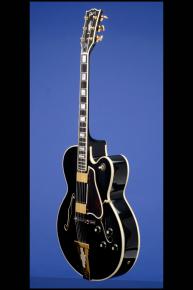"Timeless Elegance - A Jazz Icon - The inspirational Archtop Guitar"
This stunning 'custom-color' 17-inch-wide guitar weighs 7.50 lbs. and has a nut width of just under 1 11/16 inches and a scale length of 25 1/2 inches. Carved spruce top with laminated maple back and sides. Three-piece maple neck with two mahogany strips, and multi-bound ebony fretboard with a small, graceful point at the end of the fretboard, 20 jumbo frets, and inlaid pearl block position markers. The neck on this guitar has an unobtrusive volute (as typical from 1969-1981), a really comfortable medium profile and a peghead angle of 17 degrees. Nine-ply binding on the top of the guitar, five-ply binding on the back, and single-bound f-holes. Multi-bound headstock with inlaid pearl "Gibson" logo and pearl "L-5" flowerpot inlay. Black plastic bell-shaped truss-rod cover with white binding and with "Custom / L-5" engraved in white. Individual Kluson Sealfast tuners with bell-shaped metal buttons. Original tortoiseshell pickguard with five-ply (white/black/white/black/white) binding. Two Gibson 'Patent Number' humbucking pickups with "Pat No 2,737,842" engraved on the underside and nicely balanced outputs of 7.38k and 7.53k. Four controls (two volume, two tone) on the lower treble bout, plus three-way pickup selector switch on the treble horn. Black plastic ribbed-side conical-shape "Witch-Hat" knobs. Slightly-compensated solid ebony bridge on adjustable ebony base with two 'bow-tie' shaped pearl inlays. The underside of the ebony bridge base is marked in pencil "L-5 / CES 00 204664". Silver center 'insert' tailpiece engraved on top "L 5". Small oval transparent label on back of headstock lettered in gold "L-5 CES / Made in USA / 00 204664". All hardware gold plated. There is one tiny additional screw-hole on the side of the guitar just by the pickguard bracket - we assume that this was drilled at the factory for a two-screw bracket - when in fact they fitted a single-screw bracket. There is virtually no wear to the original frets on this guitar and apart from a tiny amount of tarnishing to the treble edge of the pickup covers and a few miniscule surface only marks on the sides, this spectacular and totally original example is in near mint (9.25) condition. Housed in it's original Gibson black 'Lifton' hardshell case with orange plush lining (9.25).
Known fondly as the first modern orchestra guitar and the first 'f' hole guitar the L-5 CES is usually found in varying shades of Sunburst or Natural. This 'Ebony' example is the first that we have seen… although according to the two books that we have specifically on the L-5, Black was available for a short time between 1976 and 1979… "1975/6 Cherry and black added to the regular color options" (Adrian Ingram. The Gibson L5 Its History and its Players, p.107) and "The finishes offered on the ninth model L-5CES were initially a cherry sunburst and the natural finish. However, two additional finishes were offered from 1976 through 1979. These were the wine red and ebony finishes, and these finishes were utilized to cover up the rather plain grain patterns of many L-5CES bodies and necks that were available during the mid-1970s. These finishes were discontinued in approximately 1979, but have been available on a special-order basis at various times throughout the history of the L-5CES guitar." (Thomas A. Van Hoose. The Gibson Super 400 Art of the Fine Guitar, p.118).
"The ninth model L-5CES was phased in in mid-1969, and its body again featured the Venetian cutaway. This guitar has been continued with some minor changes up to the present day. The shape of this cutaway was changed subtly in the mid-1970s but remained rounded nonetheless. The guitar continued to use Gibson humbucking pickups and the standard tone and volume control setups with pickup selector switch. The pickguards were moved back some from the cutaway and were somewhat shorter than those on the early L-5CES guitars. However, they were the same bound tortoise-like plastic material affixed to the top initially with a forward screw and the Gibson threaded rod and bracket assembly at the rim. However, in the early 1970s the simpler bent bracket was substituted for the threaded rod and bracket assembly, and this bent bracket continues to the present day. The Tune-O-Matic bridge saddle and two-footed bridge base were discontinued in the mid 1970s and were replaced by the Johnny Smith-style ebony bridge base and compensated ebony saddle. The tailpiece remained the same, but it lost the Varitone control in the early 1970s…" Thomas A. Van Hoose. The Gibson Super 400, p. 117-118.
"Timeless elegance. A jazz icon. The inspirational archtop guitar. These are just a few of the descriptions that fit Gibson’s L-5. Add to those a historical antecedent: the L-5 in various forms has been in constant production since late 1922, longer than any Martin, Gretsch, Epiphone, or National model...Originally conceived by acoustic engineer Lloyd Loar, the L-5 was the first guitar with design principles incorporated from carved instruments of the cello family. It represented a complete break from existing guitar design. Sporting simple appointments such as dot fingerboard inlays and a dark sunburst finish, the guitar was elegantly finished with a pearl 'flower pot' inlaid in the headstock below the Gibson logo, and a karat at the end of the fingerboard. The timing of the L-5’s introduction was nearly perfect since the guitar at that time was growing in popularity, but had yet to graduate from being just an instrument of vocal accompaniment to use in ensemble and orchestra settings…Certainly by the early ’40s the L-5 was a staple in jazz band and orchestral settings. At 17" across the lower bout, it was a perfectly sized instrument. Loud enough for orchestral use, but not so large and difficult to handle as Gibson’s Super 400 or the Epiphone Emperor, the L-5 was extremely popular among musicians in jazz, country and western, and large orchestras" (Eric C. Shoaf, "Gibson L-5: Loyd Loar's Timeless Masterpiece" at http://www.vintageguitar.com/brands/details.asp?ID=154).
Translate:









